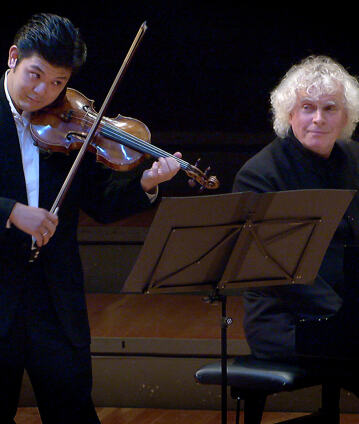A “Late Night” concert with French chamber music and Simon Rattle at the piano

The two French chamber music works of this Late Night concert show evidence of existential crises – but without sacrificing elegance. Olivier Messiaen wrote his Quatuor pour la fin du temps in 1940/41 in a German prisoner-of-war camp, surrounded by death. Claude Debussy composed his violin sonata in 1917, while he was seriously ill. Members of the Berliner Philharmoniker perform with Sir Simon Rattle at the piano.
After being conscripted by the French army in 1939, Olivier Messiaen became a German prisoner of war a year later and was deported to Görlitz prison camp STALAG VIII A. It was there that the composer, with death before his eyes every day, wrote his Quatuor pour la fin du temps around the turn of the year 1940/41. Messiaen’s inspiration for this work came “straight from [...] the Apocalypse”, as it is portrayed in the Book of Revelation. With the approval of the camp commander, Messiaen and three other inmates performed the premiere of the Quatuor pour la fin du temps before more than 400 Belgian and French prisoners of war on 15 January 1941. “The audience was an extremely diverse mixture from all walks of life – agricultural workers, labourers, intellectuals, professional soldiers, doctors and clergy,” as the composer later recalled. “Never again have I been listened to with such attention and understanding as then.”
According to Messiaen, the musical language of the eight-movement composition for clarinet, violin, violoncello and piano is “disembodied, spiritual, and catholic. The thematic motifs, which melodically and harmoniously form a kind of tonal omnipresence, bring the listener closer to eternity in space and infinity. Particular rhythms, free from any measure, strongly contribute to moving the temporal into the distance.” The performance of Messiaen’s singular and – despite the circumstances of its composition – timeless work is the main work in this late night concert with Sir Simon Rattle on the piano, the orchestra’s principal clarinet Wenzel Fuchs, 1st concertmaster of the Berliner Philharmoniker Daishin Kashimoto and the orchestra’s 1st principal cello Ludwig Quandt forming the ensemble. To open this late night event, Sir Simon and Daishin Kashimoto also perform the Sonata for Violin and Piano by Messiaen’s fellow countryman, Claude Debussy.
© 2017 Berlin Phil Media GmbH
Category
Our recommendations
- “Late Night” concert with Simon Rattle and Barbara Hannigan
- “Late Night” concert with Simon Rattle and Magdalena Kožená
- Schubert’s “Winterreise” with Christian Elsner and Simon Rattle
- “Late Night” concert with Patricia Kopatchinskaja
- “Late Night” concert with Simon Rattle
- “Late Night” between jazz and classical music with Michael Wollny and Christian Jost